HBP
OBP
ABP
Reproducibility, study power, and sample size
+++
+
+++
Exclusion of white coat hypertension
+++
−
+++
Observer bias elimination
+++ (automated devices or tele-monitoring)
+
+++
Placebo effect elimination
+++
−
+++
Assessment of magnitude of BP changes
+++
+
+++
Assessment of duration of antihypertensive drug action
++
+
+++
Time-course of BP lowering effect (days)
++
+
−
Assessment of homogeneity of antihypertensive drug action (smoothness index)
−
−
+++
Assessment of morning hypertension
+++
+
+++
Assessment of nocturnal hypertension—detection of non-dippers
++ (devices which monitor asleep BP)
−
+++
Identification of masked uncontrolled hypertension
+++
−
+++
Diagnosis of true resistant hypertension
++
+
+++
Assessment of short-term variability
−
−
++
Assessment of mid-term variability
++
−
−
Assessment of long-term variability
++
++
+
Association with preclinical organ damage
+++
+
+++
Assessment of arterial stiffness
−
−
++ (AASI)
Assessment of treatment-induced changes in organ damage
++
+
+++
Association with cardiovascular events risk
+++
+
+++
Compliance with drug treatment
+++
+
+
Patients’ preference
+++
+
+
Repeated monitoring in longitudinal trials
+++
++
+
Cost
+++
++
+
Advantages of Self-Home Blood Pressure Monitoring
HBPM has the unique advantage of providing multiple readings obtained over several days, weeks, or months, in the individual’s usual environment. On the contrary, office or clinic blood pressure measurement provides only few readings taken in an artificial and potentially stressful setting. Twenty-four hour ambulatory blood pressure monitoring (ABPM) also provides multiple measurements away from the office, yet these are crowded during a single day and cannot be frequently repeated. Because of these features, HBPM, as well as ABPM, are devoid of several major deficiencies of the conventional office measurements, including white coat effect (WCE), masked hypertension effect, the placebo effect , and observer prejudice and bias (when using automated electronic devices for home monitoring) [1, 2].
Because of the above mentioned advantages, HBPM has superior diagnostic accuracy and reproducibility than office measurements, with the standard deviation of the mean difference between two measurements being much lower than that achieved with casual office measurements (Fig. 19.1) [3]. More importantly, HBPM provides reliable predictive information, with strong associations with indices of preclinical organ damage and risk of cardiovascular events, which are superior to those obtained by office measurements and similar to those by ABPM [4–6].
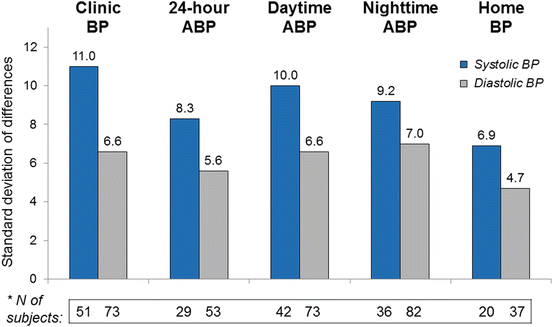

Fig. 19.1
Reproducibility of clinic, ambulatory, and home blood pressure, and sample size required for a comparative parallel design clinical trial of two antihypertensive drugs using each method (modified from [3]). BP blood pressure, ABP ambulatory BP, N number, Asterisk, required for a trial aiming to detect a difference in the effect of two drugs of 10 mmHg systolic or 5 mmHg diastolic BP with 0.90 power and 0.05 significance level
Another advantage of HBPM is that it entails less discomfort and minimal restriction of daily activities and sleep, and therefore is more acceptable by patients than ambulatory monitoring [7, 8]. Thus, HBPM appears to be the optimal method for long-term follow-up of treated hypertension and has been shown to improve compliance with drug treatment and thereby hypertension control rates [9]. Last but not the least, HBPM not only can provide reliable guidance in treatment initiation and adjustment, but it can also be a more affordable choice for hypertension management in the community, since the cost of applying the method for treatment decision, titration, and follow-up appears to be lower than when using conventional office measurements complemented by ABPM [2, 10–13].
Self-Home Blood Pressure Monitoring in Clinical Research
The advantages of HBPM compared to conventional office measurements have important implications in clinical research. HBPM improves the sensitivity and accuracy of clinical trials and allows for the evaluation of additional aspects of the blood pressure profile and behavior at baseline and in response to blood pressure lowering interventions.
Subject Selection for Clinical Trials
The selection of appropriate study participants with homogenous characteristics is of vital importance for clinical research. By using HBPM instead of office measurements, a hypertension phenotype is accurately defined and subjects with intermediate phenotypes, such as white coat or masked hypertension, can be identified and excluded [14–16]. Subjects with white coat hypertension (WCH) show minimal response to antihypertensive drug treatment compared to sustained hypertensives [17] and may create diluting effects in the assessment of reductions in blood pressure.
Studies of resistant hypertension, defined as uncontrolled blood pressure on triple antihypertensive drug therapy, demonstrated the importance of using ABPM or HBPM for the exclusion of the WCH, which is common even among treated subjects [18]. Recent studies assessing the effectiveness of renal denervation have clearly demonstrated the importance of out-of-office blood pressure monitoring for the reliable diagnosis of resistant hypertension [19].
Moreover, because of its superior reproducibility, HBPM as well as ABPM provides a more accurate classification of the true baseline blood pressure of an individual.
Sample Size and Study Power
The reproducibility of a blood pressure measurement method, expressed as the standard deviation of differences, is an important factor in the calculation of the sample size required for a clinical trial. Because of its superior reproducibility (Fig. 19.1), HBPM as well as ABPM when used in a clinical trial comparing the antihypertensive efficacy of two drugs allow the same difference in blood pressure lowering effect to be identified with higher precision [3]. Alternatively, HBPM and ABPM allow a smaller sample size to be recruited in order to identify a difference in the blood pressure lowering effect of two drugs with the same study power (Fig. 19.1) [20–23].
The power curves of a randomized cross-over clinical trial comparing the antihypertensive efficacy of two drugs using clinic, ambulatory, or home blood pressure measurements are shown in Fig. 19.2 [24]. According to these data, for a trial aiming to detect a difference in the hypotensive effect of the drugs of 10 mmHg for systolic blood pressure, 5 mmHg for diastolic, or 3 mmHg for pulse pressure, the study power is much higher when using HBPM and ABPM instead of office measurements (Fig. 19.2) [24].
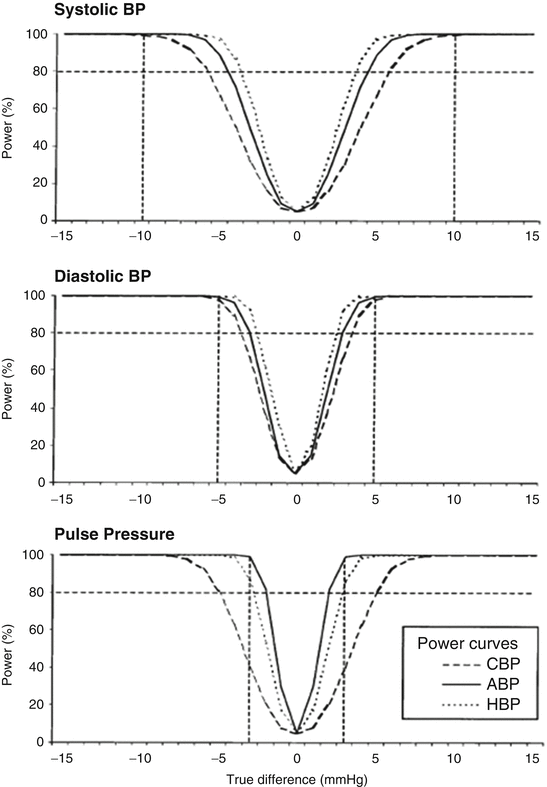

Fig. 19.2
Study power curves of a randomized crossover clinical trial comparing the efficacy of two antihypertensive drugs using blood pressure measurements in the clinic, at home, and with ambulatory monitoring (from [24]). BP blood pressure, CBP clinic BP, ABP 24-h ambulatory BP, HBP home BP, Horizontal dotted lines indicate 80 % power to detect a difference in the hypotensive effect of the drugs of 10 mmHg for systolic, 5 mmHg for diastolic BP, or 3 mmHg for pulse pressure (vertical dotted lines)
Assessment of Magnitude of Antihypertensive Drug Action
Because of its superior reproducibility, HBPM allows for the identification of antihypertensive drug treatment-induced blood pressure changes with greater precision and without the placebo effect , which largely affect clinical trials using clinic blood pressure measurements [25]. A randomized parallel design-controlled study, which evaluated the antihypertensive efficacy of the angiotensin converting enzyme inhibitor trandolapril versus placebo, showed no difference in blood pressure lowering effect compared to placebo when clinic measurements were used [26]. However, a significant placebo-corrected blood pressure lowering effect was observed when HBPM was employed (Fig. 19.3) [26]. Another randomized parallel design clinical trial comparing the beta-blocker bisoprolol with the calcium channel blocker nitrendipine found no difference in the antihypertensive effect of these two drugs when clinic or daytime ambulatory blood pressure was used, whereas self-home and daytime ambulatory blood pressure measurements demonstrated a significantly larger effect with bisoprolol (Fig. 19.4) [21]. For this particular study to have the sensitivity to identify a 10 mmHg difference between the effects of the two drugs on systolic blood pressure, at total of 118 subjects would be required if clinic blood pressure measurement were used, compared to 70 with ABPM and 56 with HBPM [21].
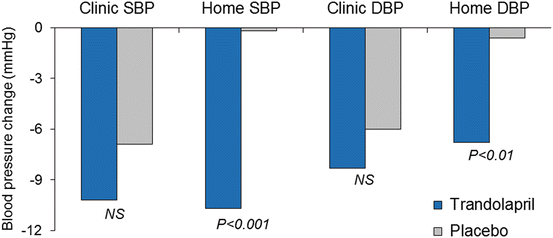
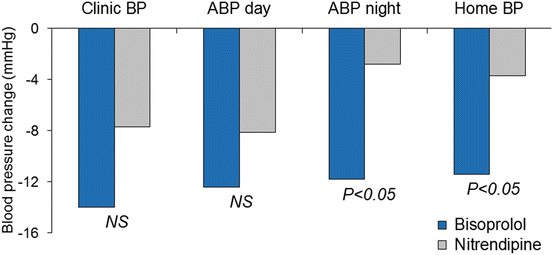

Fig. 19.3
Evaluation of the antihypertensive efficacy of a drug in a parallel design placebo controlled clinical trial using clinic or home systolic (SBP) and diastolic blood pressure (DBP) measurements (modified from [26])

Fig. 19.4
Comparison of the antihypertensive efficacy of two drugs in a parallel design clinical trial using clinic, ambulatory, and home blood pressure measurements (modified from [21]). BP blood pressure, ABP ambulatory BP
Another randomized cross-over clinical trial comparing the antihypertensive efficacy of the angiotensin converting enzyme inhibitor lisinopril with the angiotensin receptor blocker losartan showed that although all the blood pressure measurement methods (clinic, ambulatory, and home) suggested that lisinopril was more effective (Fig. 19.5), the difference between the two drugs was demonstrated with greater precision using HBPM (p < 0.001) than 24-h ABPM (p < 0.01), and the poorest precision for demonstrating this difference was provided by clinic measurements (p < 0.05) [24]. Lisinopril was also found to be more effective in reducing home pulse pressure (p < 0.01) and 24-h ambulatory pulse pressure (p < 0.03), whereas no such difference was detected using clinic measurements (Fig. 19.5) [24].
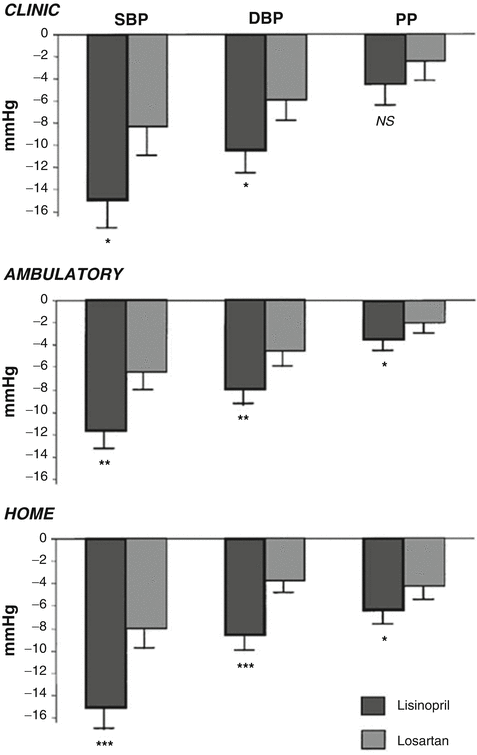

Fig. 19.5
Randomized crossover comparative clinical trial of the effects of two antihypertensive drugs on clinic, 24-h ambulatory, and home blood pressure (from [24]). SBP, systolic blood pressure; DBP, diastolic blood pressure; PP, pulse pressure; *, p < 0.05; **, p < 0.01; ***, p < 0.001 for differences between the two drugs)
These data clearly demonstrate that the use of HBPM increases the sensitivity and precision of clinical trials assessing the efficacy of antihypertensive drug action . The benefits of HBPM are attributed to its superior reproducibility, the absence of the placebo effect , the regression dilution bias (regression to the mean), and the observer prejudice and bias (when electronic devices with automated memory are used), all of which limit the reliability of clinical trials based on clinic blood pressure measurements.
Assessment of Duration of Antihypertensive Drug Action
The duration of antihypertensive action and 24-h coverage are usually assessed using the trough-to-peak ratio (T/P), which is based on 24-h ambulatory or on clinic blood pressure measurements [27]. The morning-to-evening (M/E) home blood pressure ratio assessed by self-monitoring can provide information of the “trough” effect of the drug by obtaining morning measurements before drug intake and the “plateau” effect in the evening [28]. Studies have shown that the M/E home blood pressure ratio might be a useful alternative to the T/P ambulatory blood pressure ratio for assessing the duration of antihypertensive drug action [29–31]. A randomized clinical trial that compared the duration of the antihypertensive drug action of the angiotensin converting enzyme inhibitor lisinopril with the angiotensin receptor blocker losartan showed higher T/P and M/E blood pressure ratios (evaluated by ABPM and HBPM respectively) with lisinopril, which was consistent when the analysis was restricted to subjects with significant blood pressure response to treatment (Fig. 19.6) [29].
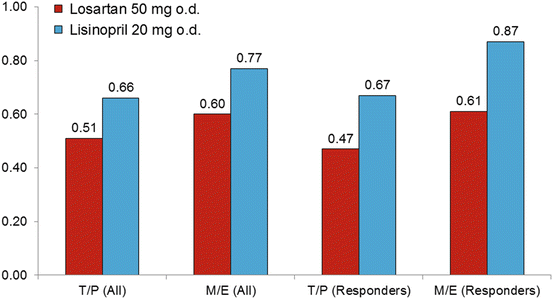

Fig. 19.6
Morning-to-evening (M/E) home blood pressure ratio versus trough-to-peak (T/P) ambulatory blood pressure ratio for assessing the duration of antihypertensive effect of two drugs in all study subjects and in those who responded to treatment (modified from [29])
A similar mathematical expression is the difference between morning and evening home blood pressure values (morning-evening difference), which has been shown to be a significant determinant of echocardiographic left ventricular hypertrophy (LVH) , geometry, and diastolic function [32]. It should be mentioned, however, that the M/E home blood pressure ratio does not provide information on the peak effect of treatment and might therefore fail to identify an excessive hypotensive effect at peak.
Evaluation of Nocturnal Blood Pressure and Detection of Non-dippers
ABPM is regarded as a unique tool, because it allows the evaluation of blood pressure during nighttime sleep and thereby the detection of non-dippers. This advantage appears to have major clinical relevance because of the accumulating evidence suggesting that, compared to other aspects of the blood pressure profile, nocturnal blood pressure is the strongest predictor of cardiovascular risk. Non-dippers have demonstrated a higher risk of preclinical organ damage and cardiovascular events than dippers [33].
Advancement in technology of automated home blood pressure monitors provided the ability to obtain automated readings throughout nighttime sleep [34]. There is evidence that nocturnal home monitoring gives reproducible blood pressure values [34]. A cross-sectional study showed similar daytime and nighttime blood pressure levels assessed with home and ambulatory blood pressure and good agreement between the two methods in diagnosing non-dippers [35]. More importantly, these devices can provide nocturnal blood pressure evaluation for more than a single 24-h period, which is the case with ambulatory monitoring. The Japan Morning Surge—Home Blood Pressure (J-HOP) Study showed that automated asleep home blood pressure evaluated three times per night for at least two (average 9) nights gave comparable blood pressure values with nighttime ambulatory blood pressure [36]. More importantly, nocturnal systolic home blood pressure was more closely associated with indices of cardiac and renal organ damage than nocturnal ambulatory blood pressure [36]. Ishikawa et al. also reported significant association of nighttime home blood pressure with hypertensive target organ damage [37].
Thus, HBPM appears to be a useful alternative to ABPM even for the evaluation of nocturnal hypertension and might be more appropriate for the evaluation of treatment-induced changes in nocturnal blood pressure in clinical trials, because it can provide multiple assessments on different days and at lower cost.
< div class='tao-gold-member'>
Only gold members can continue reading. Log In or Register to continue
Stay updated, free articles. Join our Telegram channel

Full access? Get Clinical Tree


